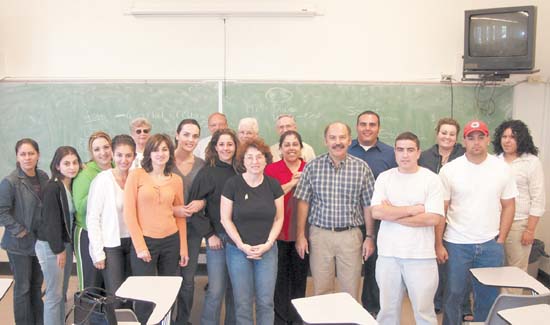Zhanna Bagdasarov and Marine Ekezyan
Staff Writers

One might think that taking a weekend class would be time consuming and that you might lose a weekend of relaxation. However, taking the Armenian Studies 120T-Armenian Church class offered by the Armenian Studies Program during the weekend of October 10th and 11th proved to be an atypical experience. As soon as the students began to walk into a room filled with Armenian Church music, the earlier notions faded away.
Professor Barlow Der Mugrdechian, the instructor for this course, began his discussion with information concerning the background and organization of Armenian churches throughout the world. There was a lot of information shared during the course, yet what really made this class stand out from other classes was the first-hand experience students received by actually visiting an Armenian church.
On Saturday morning, the entire class met at St. Paul Armenian Church, on the corner of First and Dakota streets. Because Professor Der Mugrdechian is a Deacon at this church, the students were able to take a tour of the church. The subject of Armenian art came up several times during the class, and so the tour began with an examination of the frescoes on the interior walls of the church. He also explained the meaning of every stained-glass window in the church, each of which forms a part of the larger story of the history of Christianity in Armenia. Then the class gathered in the narthex of the church, where Der Mugrdechian explained the meaning of a typical Sunday Divine Liturgy.
Student Ani Estefanian expressed her feelings while at the church, “I wasn’t aware of the importance and symbolism that underlined the importance of the artwork within the church, but now that I’m enlightened, I wish all Armenians were aware and appreciative of this aspect of our culture.”
It was to the students’ advantage to have Professor Barlow Der Mugrdechian teaching this course because he didn’t just acquire knowledge of this topic through books, but also gained an understanding through personal experience. For instance, he was one of the delegates elected to participate in the election of the Catholicos of All Armenians in Etchmiadzin in 1999. It is because of these experiences that he was able to contribute interesting facts and stories regarding this subject.
Another feature of this class that contributed to the enjoyment felt by the students was the incredibly detailed video about the preparation and blessing of the Holy Oil (Muron). “Watching the video of this event made me realize just how ceremonial and extensive this process is and it was interesting to find out that the oil is only made one batch at a time and is distributed to all the Armenian churches throughout the world,” commented student Barseg Abanyan.
Next time you consider taking a weekend class, don’t let your preconceptions prevent you from taking a course that would broaden your horizons and open your eyes to see that the history of Armenian Church is significant. The Church has built our culture and shaped us as a nation. Even today, our everyday perceptions of life are influenced by this history.
 Hye Sharzhoom Armenian Action
Hye Sharzhoom Armenian Action